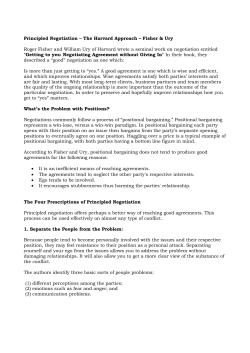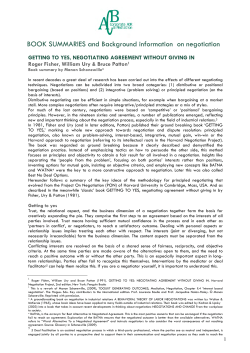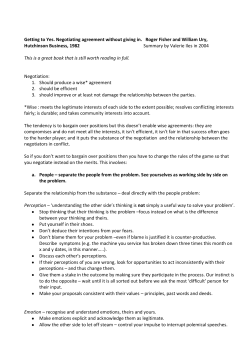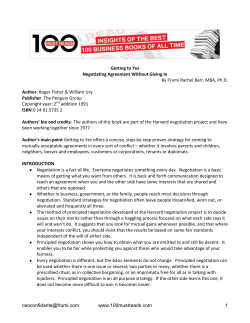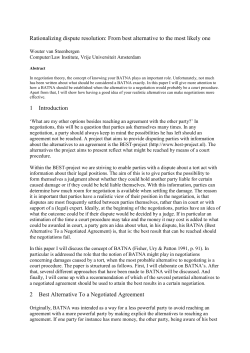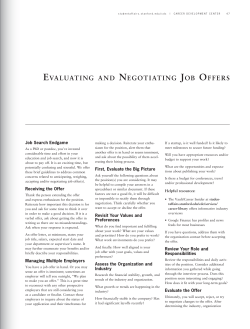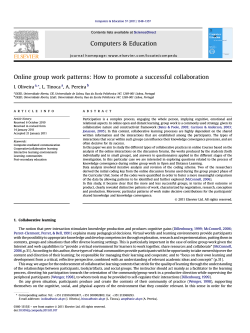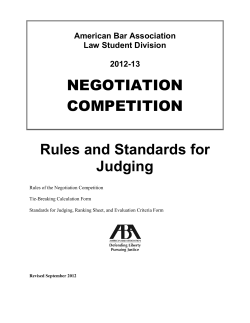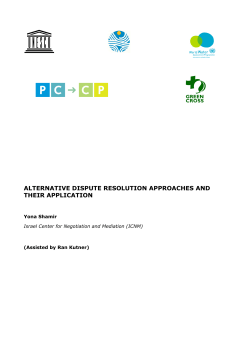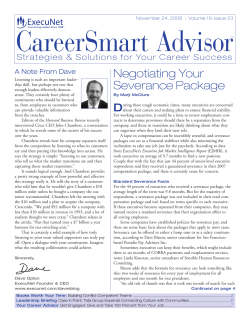
NEGOTIATION AND COLLABORATIVE PROBLEM SOLVING Wake County Stormwater Ordinance Committee
Negotiation and Collaborative Problem Solving NEGOTIATION AND COLLABORATIVE PROBLEM SOLVING Wake County Stormwater Ordinance Committee Raleigh, NC December 2005 Table of Contents Concepts In Negotiation............................................................................................ 1 Preparing to Negotiate .............................................................................................. 6 Making Smart Decisions ........................................................................................... 9 Stages Of The Collaborative Process ..................................................................... 12 Principled Negotiation ............................................................................................. 15 Communicating Through Conflict............................................................................ 17 Thinking About Consensus ..................................................................................... 22 Forms of Agreement ............................................................................................... 25 Durable Agreements ............................................................................................... 26 © L. Steven Smutko, Natural Resources Leadership Institute, NC State University. 2005 i Negotiation and Collaborative Problem Solving ii © L. Steven Smutko, Natural Resources Leadership Institute, NC State University. 2005 Negotiation and Collaborative Problem Solving CONCEPTS IN NEGOTIATION Decision Perspectives Individual decision-making perspective Also referred to as decision analysis, a systematic analysis from a single perspective • A process you should undertake before entering a negotiation • Provides a theoretically well founded methodology to structure your negotiation problem • Also helps you decide with whom you should negotiate • Helps you frame the decision in terms of the alternatives available to you and potential consequences of each alternative • Helps you compare the benefits of a joint agreement with the benefits gained from separate or unilateral action (evaluate BATNAs) • Other negotiators’ possible decisions can be folded into the analysis as uncertainties • Five steps of decision analysis: 1. Identify the problem (What are the essential elements of the problem?) 2. Clarify your objectives (What concerns to you hope to address through your decision? Convert your concerns into objectives.) 3. Generate creative alternatives (What are your potential choices for pursuing your objectives?) 4. Evaluate the consequences (What are the consequences of acting on your decision?) 5. Make tradeoffs (What the tradeoffs of selecting one objective over another? Can you rank them in order of importance to you?) Interactive decision making perspective • Based on the presumption that your payoff is not determined solely by your actions, but by the separate interacting actions of all the negotiators • As a negotiator you consider the alternatives, interests, aspirations, and behaviors of others • Thinking strategically about the interaction of separate decisions should help you to understand the underlying threats and opportunities and how you can improve your leverage in a negotiation • The interactive perspective helps you think about how other parties will interpret proposals, honor agreements, and respond to offers Joint decision-making perspective • Emphasizes the opportunities for cooperation between parties • Negotiators use communication to facilitate the drafting of joint agreements that benefit of both sides. • Helps you avoid falling into the trap of negotiating solely on the basis of what is individually rational • Negotiators explore agreements that are mutually superior to alternatives that arise through separate interactive decisions © L. Steven Smutko, Natural Resources Leadership Institute, NC State University. 2005 1 Negotiation and Collaborative Problem Solving An adept negotiator can move back and forth between individual, interactive and joint decisionmaking perspectives, synthesizing insights along the way to arrive at well-informed decisions. Experimental evidence shows that, when left to our own devices, we are not much good at negotiating optimal deals. Analytical perspectives can help. But to achieve the best solution that you can, you will need to strike a balance between your analytical endeavors and your cognitive capabilities. Implementing the fruits of analysis relies on your bargaining skills, your powers of persuasion, your nimble thinking, your knowledge of body language, your inventiveness and creativity, your willingness to use credible threats, your skills at drafting complex deals, your coalition-building expertise, your linguistic abilities… the list never ends. Howard Raiffa, Negotiation Analysis: The Art and Science of Collaborative Decision Making. Harvard University Press. 2002. 2 © L. Steven Smutko, Natural Resources Leadership Institute, NC State University. 2005 Negotiation and Collaborative Problem Solving Solution Possibilities Frontier Some negotiation dynamics can be illustrated using the dual concerns model shown below. The graph illustrates the potential outcomes of two negotiators (You and Me) who employ different strategies based on their concern for their own interests and the interests of the other negotiator. The model can also be used to illustrate the selective application of three decision perspectives: individual, interactive, and joint. Accommodate/Compete (you get 10, I get 1) Compete/Accommodate Avoid/Ignore (you get 1, I get 10) (you get 10, I get 1) Avoid/Ignore In the bottom left quadrant of the graph labeled Avoid/Ignore, each negotiator shows low concern for his own interests and the interests of the other. Hence they avoid negotiating and gain or lose little. This situation can also arise when negotiators choose to interact, but may be ignorant of their own © L. Steven Smutko, Natural Resources Leadership Institute, NC State University. 2005 3 Negotiation and Collaborative Problem Solving options, or unable to effectively negotiate. Hence, they reach an outcome that is inferior to one they could have reached had they been better informed. Accommodate/Compete Two negotiators thoughtfully employing an individual and interactive negotiation perspective can expect to work their way toward some solution set where one or the other can maximize his or her gains. This solution set, called the solution possibilities frontier, represents the entire set of possibilities that each negotiator can achieve. In other words, this defines the size of the pie which is to be divided between the two negotiators. Solutions on this frontier are called distributive solutions. The two ends of the frontier are labeled accommodate or compete and illustrate the result of one party maximizing his gains (competitor) at the expense of the other (accommodator). Compromise The negotiators, still skillfully employing their individual and interactive negotiation perspectives can agree to compromise and divide the pie equally. This is often achieved through the “negotiation dance” where each negotiator slowly works inward, each having started from an extreme position. When two offers are on the table, the natural focal point for further bargaining is the midpoint. In situations of distributive bargaining, empirical evidence suggests that the more the first offer is exaggerated (within reason) the more the bargainer nets, and it’s better to make the second offer because the first offers are usually not extreme enough. Collaborate Negotiators who take advantage of opportunities to employ a joint decision-making perspective, can seek integrative solutions. That is, through enhanced communication opportunities they can shift the solutions possibilities frontier and expand the pie to find solutions that can be mutually agreed upon by both. Joint decisions shift the focus from separate interactive actions to group actions. Collaboration emphasizes direct communication of interests, aspirations, expectations, beliefs, and visions of the future. Open communication allows for enhanced creativity in the actions negotiators take and the decisions they make. Negotiators can invent new strategies, create new alternatives, and develop new ways of implementing agreements. Full, Open, Truthful Exchange (FOTE) Joint decision-making emphasizes direct communication of interests, aspirations, expectations, beliefs, and concerns. This contrasts sharply with the competitive, winner-take-all style of negotiation that we often associate with this term. All too often, bluffing, threats, exaggeration, concealment, and outright lies come to mind when we think of negotiations. But to effectively engage in a negotiation process where decisions are made together, by all parties, and the payoffs are knowingly distributed among them, then some form of full, open, truthful exchange (FOTE) is necessary. Open exchange among parties spurs creativity in the actions negotiators take and the decisions they make. Mutual exchange of documents, informal briefings, clear statements of interest, and brainstorming are all methods of open exchange. Negotiators need to be clear about what information they can and should openly exchange. For example, they may be reluctant to disclose their bottom lines – their reservation values. In such cases, partial, open truthful exchange (POTE) may be satisfactory. The Negotiator’s Dilemma Claiming Value through the Negotiation Process • 4 Pursue your interests through a single-minded focus on the end game © L. Steven Smutko, Natural Resources Leadership Institute, NC State University. 2005 Negotiation and Collaborative Problem Solving • Use individual and interactive decision perspectives • Negotiate tough, scrutinize the details, focus on the rewards, find the pressure points, and control the process Creating Value through the Negotiation Process • Pursue mutual gains using interest-based negotiation • Open channels of communication, deal directly and empathetically with each other, and focus on the underlying human interests of each negotiator The Negotiator’s Dilemma • Creating value through an interest-based approach directly conflict with competitive strategies intended to claim value • Openly sharing information to discover joint interests leaves negotiators vulnerable to valueclaiming strategies • The result is that good ideas often remain undisclosed • Shared interests can be held hostage in exchange for concessions on other issues Negotiator Utility Assessment (How I know I did well) People negotiate so long as they can satisfy their interests better through negotiation than they can by pursuing their best alternative to a negotiated agreement (BATNA). People gauge how well they perform in a negotiation by the benefits they derive from the experience. Negotiators posses numerous and varied interests. Most often, we think about these interests as germane to the topic under discussion, usually measured in familiar units such as dollars of income, acres of habitat, acrefeet of water, and so on. But just as often, negotiators are weighing their level of success on less substantive criteria. We can think of negotiation utility emanating from the satisfaction of four types of interests. Substantive gains These are the typical things we think of as the subject of the negotiation and expressed in measurable terms such as the price of a car. Although negotiators’ ideas about their interests may change over the course of the negotiation, they need to come away with some sense of substantive satisfaction; a sense that they got what they came for. Fairness Even if they get what they want, parties will not be satisfied if they think the process was not "fair." This is a subjective assessment, but a powerful one. Reputation Negotiation is a social activity that revolves around the relationships of those at the negotiating table, and the relationships of negotiators and their constituents. In this sense, negotiators have a reputation to uphold, be it a reputation for winning, for fairness, or honesty. Everyone needs to feel heard and respected. Should a negotiator feel his or her reputation was damaged for some reason, the negotiation can fail or an agreement may not prove durable. Justice Negotiators often measure their success by the success or failure of other parties. For many, wrongs must be made right and others must account for their actions. This may be an underlying interest that does not surface in the deliberations. It is subtle yet powerful © L. Steven Smutko, Natural Resources Leadership Institute, NC State University. 2005 5 Negotiation and Collaborative Problem Solving PREPARING TO NEGOTIATE1 Understand the purpose of negotiation The purpose of negotiation is not always to reach agreement. Agreement is only one means to an end, and that end is to satisfy your interests. The purpose of negotiation is to explore whether you can satisfy your interests better through agreement than you could by pursuing your Best Alternative To a Negotiated Agreement (BATNA). Three phases of Preparation Alone, Clarify Your Own Thinking Plan alone to review the realities of the situation. Determine your strengths and weakness, the resources you bring to the negotiation, and the resources you lack. Think through the following questions: A. What are your concerns and interests? Think about what you want. Not how much of it, but what is it you really care about? Begin to take stock of what you need, and what you hope to gain by negotiating. Think about the large things like contributions to society, your standing with others in your organization or outside your organization. Think about fairness and equity; establishing a good working relationship with the other side; your problem-solving style. B. What are your visions for the future? Keep the opportunities for long-term benefits in sight. Dream about the possibilities that could become real if negotiations are successful. What do you aspire to? Be prepared to share your vision with the other side. C. What options might meet your interests, solve your concerns, and be acceptable to the other parties? Undertake a brainstorming process to consider a range of alternatives that meet your interests. Be imaginative. Also consider alternatives that may work for the other side. If you can keep the other side happy while satisfying your needs, they may be willing to reciprocate. Also think about options you want to avoid, those that would be sufficiently harmful to their side that you could stymie negotiations just by suggesting them. D. What are the comparative advantages of all parties in the negotiation? Each side comes to the table with different strengths. Try to understand those differences and devise ways to use them to the advantage of all parties. Is one group time-rich but money-poor and vice versa? Figure out ways that you can exploit these differences in beneficial ways. E. What are your alternatives to the proposed negotiation? 1 From Roger Fisher and William Ury Getting To Yes: Negotiating Agreement Without Giving In, 2nd Edition. Penguin Books, New York, 1991. and, Howard Raiffa. Negotiation Analysis: The Science and Art of Collaborative Decision Making. Belknap Press. Cambridge, MA. 2002. 6 © L. Steven Smutko, Natural Resources Leadership Institute, NC State University. 2005 Negotiation and Collaborative Problem Solving Once negotiations get going, it’s easy to fall in love with making a deal, so it’s important for negotiators to keep their alternatives in mind. The better your alternatives the more you can expect from the negotiation. Do more than simply articulate alternatives, make them real. Act on them so that you can invoke them when needed. Think about your alternatives to negotiation in three ways: • BATNA: Best Alternative to a Negotiated Agreement • WATNA: Worst Alternative to a Negotiated Agreement • MLATNA: Most Likely Alternative to a Negotiated Agreement Identify your alternatives, your key to leveling the playing field • "Walk-away" alternative: the alternative you invoke if you break off negotiations. • "Interactive" alternative: the alternative that you invoke to make your opponent respect your interests and keep negotiations going. • "Third-party" alternative: bringing in a third-party neutral to help further your interests. F. How will you evaluate options? You want A, the other side wants B. How should you decide? You could argue the benefits of choosing A and the problems with selecting B, but the other side will only do the same, but in reverse. Instead, you must devise a set of criteria that you can both agree to, one that would appeal to a neutral outsider who is interested in fairness and equity. Consider fair standards or procedures that you could invoke to evaluate options that would appeal to the other side. Be prepared to undertake a joint search with the other side for a set of criteria that work. G. What do you know about other negotiators? It is important that you enter a negotiation with some information about the people and organizations you will be negotiating with (i.e. the other side). You may not have complete and accurate information before beginning your negotiation. Instead, you may want to create some theories about them, and test them during the negotiation. • Who are the other stakeholders (parties)? • Why do they want to negotiate with you? • Why now? • What are their interests? • What perceptions do they have that might complicate matters? • If they don’t negotiate, what is their best alternative (BATNA)? • How good is their BATNA? • What resources do they bring? H. What can I determine about the unknown? Without a doubt, you will be entering a negotiation with a lot of unknowns. Uncertainties exist about the issues, the strength of possible options, important external factors, and many other variables that can affect the negotiations and your decisions. It is important that you gain some understanding about what exactly is uncertain, the level of uncertainty, and the degree to which those uncertainties may affect your decision making. • What are the key uncertainties about your particular issue? • How important is certainty (or uncertainty) to the resolution of the particular issue? © L. Steven Smutko, Natural Resources Leadership Institute, NC State University. 2005 7 Negotiation and Collaborative Problem Solving • • What data or information can you collect to reduce the uncertainty? Can you assign levels of uncertainty (probability) to the issue? Together, Prepare to Negotiate After taking the time necessary to work through the above questions alone, it is now time to come together with the other negotiators and have an informal pre-negotiation dialogue. A. Plan the logistics Decide who will negotiate, how many from each party will be present, and the roles of each. Where will the meetings take place? Who is responsible for expenses? Is there a need for a third-party neutral? If so, how will one be selected? B. Set goals and create ambiance Generally, the purpose of a pre-negotiation dialogue is to determine what should be negotiated and how the parties will go about it. You want to avoid engaging in mutual competitive tactics that will impede joint creativity. Instead, you want to establish a tone of openness and safety. Try to build trust and enhance the abilities of the other negotiators to communicate openly and effectively. The idea is to take this opportunity to create joint value. C. Share interests Selectively share your visions for the future. Let them know what is important to you, you’re your concerns are, and what you really want. Open the door for the other negotiators to do the same. Adapt your divulgences to the willingness of the other negotiators to divulge their interests. Try to reframe the issues to solvable problems by asking the question, “How can we… while at the same time…?” D. Agree on a process Between all the negotiators, agree on rules and procedures that will govern the process. Spend as much time as necessary to arrive at a set of firm rules. You may go so far as to codify the process rules into a memorandum of agreement or charter. E. Prepare a negotiation template Identify the issues to be resolved and the range of possible resolutions [TEMPLATE EXERCISE] Alone, Evaluate the Jointly Created Negotiation Template [CONTINUE TEMPLATE EXERCISE] 8 © L. Steven Smutko, Natural Resources Leadership Institute, NC State University. 2005 Negotiation and Collaborative Problem Solving MAKING SMART DECISIONS2 The Decision Problem A good solution to a well posed problem is nearly always more satisfying than an excellent solution to a poorly conceived problem. • Define the problem (the decision context) o Ask, “What triggered this decision. Why am I even considering it?” • Identify the essential elements Objectives Objectives form the basis for evaluating alternatives available to you. If you clearly and accurately specify all your objectives, your chances of making a good decision are inordinately improved. • Identify your objectives o List all the concerns you hope to address through your decision o Convert your concerns into objectives o Separate ends objectives from means objectives Each means objective can serve as a stimulus for generating alternatives and can deepen your understanding of your decision problem Only fundamental objectives should be used to evaluate and compare alternatives o Clarify what you mean by each objective o Test your objectives to see if they capture your interests Alternatives Alternatives represent the range of potential choices you have for pursuing your objectives, and so are the foundation for decision making. You can never choose an alternative you haven’t considered, and no matter how many alternatives you have, our chosen alternative can be no better than the best of the lot. • Expand your thinking and your alternatives o Avoid “business as usual” o Think big and be creative, don’t “incrementalize,” just go with the usual, or choose the first possible solution o Challenge constraints o Set high aspirations o Do your own thinking first, then ask others o Create alternatives first, evaluate them later • Tailor your alternatives to your problem o Process alternatives 2 This chapter is a summary of the text, Smart Choices: A Practical Guide to Making Better Live Decisions, by John S. Hammond, Ralph L. Keeney, and Howard Raiffa, Broadway Books, New York, 1999. © L. Steven Smutko, Natural Resources Leadership Institute, NC State University. 2005 9 Negotiation and Collaborative Problem Solving o Information gathering alternatives o Time-buying alternatives Consequences You need to be fully cognizant of the consequences of your decisions before you make your choice. If you don’t, you’ll find out afterwards and you may not be satisfied with the outcome. • Describe consequences with appropriate accuracy, completeness, and precision o Try before you buy o Use common scales to describe consequences; make sure scales reflect an appropriate level of precision o Don’t rely only on hard data o Make the most of available information • Build a consequences table to compare alternatives (also called an Alternatives – Objectives Matrix) Tradeoffs Decisions with multiple objectives cannot be resolved by focusing on any one objective. You need to evaluate the tradeoffs between alternatives • Find and eliminate dominated alternatives • Evaluate alternatives using absolute dominance and practical dominance • Build a “ranking table” to evaluate tradeoffs • Use the “even swap method” for evaluating tradeoffs o Concentrate on the amount of the swap, not on the perceived importance of the objective o Value an incremental change based on its relative benefit or cost o Seek out information to make informed swaps Uncertainty Create risk profiles and decision trees to simplify decisions involving uncertainty • Identify key uncertainties • Define outcomes • Assign chances of meeting outcomes Risk Tolerance Once you understand the level of uncertainty you face, you need to take your personal tolerance for risk into account in making a decision. • Understand your willingness to take risks • Incorporate your risk tolerance into your decisions o Think hard about the desirabilities of the consequences o Weight desirabilities by chances 10 © L. Steven Smutko, Natural Resources Leadership Institute, NC State University. 2005 Negotiation and Collaborative Problem Solving o Compare and choose • Quantify risk tolerance with desirability scoring • Watch out for pitfalls o Don’t over-focus on the negative o Don’t fudge the probabilities to account for risk o Don’t ignore significant uncertainty o Avoid foolish optimism o Don’t avoid making risky decisions because they are complex • Open up new opportunities by managing risk o Share the risk o Seek risk-reducing information o Diversify the risk o Hedge the risk o Insure against risk © L. Steven Smutko, Natural Resources Leadership Institute, NC State University. 2005 11 Negotiation and Collaborative Problem Solving STAGES OF THE COLLABORATIVE PROCESS A typical collaborative process has three well-defined stages3, each containing a number of steps, tasks or objectives. STAGE 1 STAGE 2 STAGE 3 Getting Started– Pre-Deliberation Searching for Agreement – Deliberation After the Agreement PostDeliberation • Initiate the process • Assess issues and stakeholders • Design a strategy • Set up a program • Establish procedures • Educate each other and specify needed information • Define the problem • Generate options • Develop evaluation criteria • Evaluate and select options • Ratify the agreement • Integrate agreement into formal processes • Implement the agreement • Keep avenues open for renegotiation • Develop a plan Stage 1 – Getting Started: Pre-Deliberation A stakeholder or a trusted outsider raises the possibility of collaboration and initiates the process. Following initiation, the pre-deliberation, or planning stage, should be carried out with a group of knowledgeable stakeholders who committed to the issue and are willing to participate in the process from the beginning. During this stage, the objectives of the collaborative process are to: Assess the issues • Identify conditions for collaboration. • Develop a clear description of the issues that need to be addressed. • Frame the problem as a joint search for resolution of the issue: "How can we...?" Identify stakeholders • Determine what (or whose) interests are at stake. • Identify who can affect - and who is affected by - the issue • Contact stakeholders and determine their needs for participating in a collaborative process. 3 Lawrence Susskind and Jeffrey Cruikshank of the MIT-Harvard Public Disputes Program in their book, Breaking the Impasse, Consensual Approaches to Resolving Public Disputes (Basic Books, Inc, New York, 1987), outline three major stages of the negotiation process. These are namely: prenegotiation, negotiation, and postnegotiation. Here, the term "negotiation" has been softened somewhat and reframed as "deliberation" in order to incorporate all types of collaborative decision-making processes. Finally, the discussion incorporates the work of Susan Carpenter in presenting a programmatic approach to public dispute resolution (Solving Community Problems by Consensus, Program for Community Problem Solving, Washington, D.C., 1990). 12 © L. Steven Smutko, Natural Resources Leadership Institute, NC State University. 2005 Negotiation and Collaborative Problem Solving Design a strategy • Consider the most productive format: committee, negotiating team or conference format. • Agree on process steps. • Identify roles and who might fill them: chairperson, facilitator, recorder, technical resources, meeting logistics, etc. • Plan your time frame. • Set up a program • Decide on logistical details: where and when to meet, agenda, etc. • Draft the meeting ground rules and protocols (also called a group charter, meeting plan or convening document). Stage 2 – Searching for Agreement: Deliberation Once all the stakeholders have been contacted, the first meeting convened, and the protocols ratified, the participants can begin to deliberate the substantive issues. The facilitator’s role in the deliberation stage is described in Volumes 9 and 11 of this series. The stakeholders’ roles are described in a special issue for citizens called Dealing with Conflict in Your Community. Establish procedures • With the whole group, ratify the meeting ground rules and protocols drafted in the planning phase. Make changes where necessary. Educate each other • Share concerns related to the topic. • Identify what is given. • Identify what is understood. • Identify sub-issues. • Identify and share interests -- reasons, needs, concerns and motivations underlying participants' positions -- rather than assert positions. Define the problem • Define the present situation. • Define the desired future. Specify information needs • Identify technical background information that is pertinent to the issue. • Identify information that is available and information that is needed. • Agree on methods for generating answers to relevant technical questions, or a path to follow even if no technical consensus exists. Educate each other (again, and whenever it is needed) • Field trips. • Collecting data/soliciting reports. • Briefings. • Interviews. Generate options • Use task forces for larger groups. • Bring in the public. • Brainstorm. • Use expert opinion. Develop criteria for option evaluation © L. Steven Smutko, Natural Resources Leadership Institute, NC State University. 2005 13 Negotiation and Collaborative Problem Solving • • • Feasibility Fairness Efficiency Evaluate options • Priority matrix • Goal achievement. Reach agreements • Building block • Single text • Agreement in principle Develop a written plan • Document areas of agreement to ensure a common understanding of the participants' accord. • Develop a plan of action: what, how, when, where, who.\ Stage 3 – After the Agreement is Reached: Post-Deliberation Once an acceptable solution has been identified, it must be approved and implemented by all responsible parties. During Stage 3, the objectives of the collaborative process are to: Ratify the agreement (Volume 10) • Parties get support for the plan from organizations that have a role in carrying it out. • Each organization follows its own internal procedures as it reviews and adopts the plan. Integrate the agreement into the public decision-making process (Volume 10) • Governing bodies and agencies not directly included in the process have been kept informed during earlier phases of the process. • Plan is considered and acted upon by the relevant agencies and governing bodies for implementation. Implement the agreement (Volume 10) • Maintain communication and collaboration as the plan is carried out. • Monitor your results. • Renegotiate, if necessary. • Celebrate your success 14 © L. Steven Smutko, Natural Resources Leadership Institute, NC State University. 2005 Negotiation and Collaborative Problem Solving PRINCIPLED NEGOTIATION4 1. Separate the People from the Problem A. Perception Put yourself in their shoes Don't deduce their intentions from your fears Discuss each others' perspectives Give them a stake in the outcome Align proposals with values B. Emotion Recognize and understand Make emotions explicit Go ahead and let them vent Recognize the tactic Don't react - buy time to think Don't get mad, don't get even, get what you want C. Communication Make the effort Listen to what they say; listen actively Speak to be understood Speak for yourself D. Prevention works best Build a working relationship Face the problem, not the people 2. Focus on Interests Not Positions A. Identifying interests Ask why; why not Realize that each side has multiple interests Most powerful interests are basic human needs Make a list B. Talking about interests C. Make them real Acknowledge their interests Put interests before your answer Look forward not back Be concrete but flexible Be hard on the problem, soft on people Build a golden bridge Involve the other side 4 From Roger Fisher and William Ury Getting To Yes: Negotiating Agreement Without Giving In, 2nd Edition. Penguin Books, New York, 1991. © L. Steven Smutko, Natural Resources Leadership Institute, NC State University. 2005 15 Negotiation and Collaborative Problem Solving Satisfy unmet interests Help them save face Go slow to go fast 3. Invent Options for Mutual Gain A. Four obstacles B. How to invent options C. Premature judgement Searching for a single answer Assuming a fixed pie Thinking that solving their problem is their problem Separate inventing from deciding Brainstorm Broaden your options Look through the eyes of different experts Invent agreements of different strengths Look for mutual gain Look for shared interests Dovetail differing interests Trade off preferences Make their decision easy 4. Use Objective Criteria A. B. Criteria need to be independent of each others' will Developing objective criteria C. Negotiating with objective criteria 16 Fair standards Fair procedures Frame each issue as a joint search for objective criteria Reason and be open to reason on which standards to choose Never yield to pressure, only to principle © L. Steven Smutko, Natural Resources Leadership Institute, NC State University. 2005 Negotiation and Collaborative Problem Solving COMMUNICATING THROUGH CONFLICT Listening For Their Interests 1. STOP TALKING – You can’t listen while you are talking. 2. EMPATHIZE WITH THE OTHER PERSON – Try to put yourself in their shoes. 3. ASK QUESTIONS – When you don’t understand, when you need more explanation, when you want to be liked, when you want to show that you are listening. 4. DON’T GIVE UP TOO SOON – Don’t interrupt other people; give them time to say what they have to say. 5. CONCENTRATE ON WHAT THE OTHER PERSON IS SAYING – Focus your attention on his/her words, ideas, and feelings. 6. LOOK AT THE OTHER PERSON – Facial and body expressions (eyes, mouth, hands) all help to communicate with you. They will make you focus too. 7. LISTEN FOR HOW SOMETHING IS SAID – Tone of voice and expression may provide more information than the content of the message. 8. LEAVE YOUR EMOTIONS BEHIND (IF YOU CAN) – Try to push your worries, fears, and problems outside the meeting room. “Step to the balcony.” 9. CONTROL YOUR ANGER – Try not to get angry at what the other person is telling you. Your anger may prevent you from understand his/her meaning. 10. GET THE MAIN POINTS – Concentrate on main ideas, not the examples. Stories, anecdotes, supporting data are important but usually not the main point. Examine them only to see if they support or clarify the main idea. Don’t “chase the red herring.” 11. EVALUATE FACTS AND EVIDENCE – As you listen, try to identify not only the significance of the data, but also their relationship to the argument. 12. REACT TO IDEAS, NOT THE PERSON – Don’t let your reactions to the person influence your interpretation of what is being said. The ideas may be good even though you don’t like the person. 13. DON’T ARGUE MENTALLY – Don’t be formulating a rebuttal while the other person is speaking to you. 14. DON’T MAKE ASSUMPTIONS – Don’t assume that… they use words in the same way you do; they don’t say what they mean but you understand what they mean; they avoid looking you in the eye because they are lying; they interpret data the same way you do; they have access to the same information you do; they are trying to do you harm because they don’t agree with you; they are distorting the truth because they don’t agree with you. Observe the Behavior of Others Learn to look (listen) for both the content and the conditions in a conversation. The content will often tell you one thing while the conditions (behaviors) tell you another. Look (listen) for: Masking – Understating or selectively showing their true opinions. Sarcasm, sugarcoating, and couching are ways that we can mask our true meaning Sure, whatever you say. (I really think your idea stinks.) © L. Steven Smutko, Natural Resources Leadership Institute, NC State University. 2005 17 Negotiation and Collaborative Problem Solving Avoiding – Staying completely away from sensitive subjects. We talk but don’t really address the tough issues. Okay, I’ll go along with your plan. (This is unfair! We always do what you want us to do.) Withdrawing – Pulling out of communications altogether, losing even the possibility of dialogue in order to steer clear of difficult topics. I’m sorry, but I can’t be at the meeting today. Something’s come up. (I’m not touching that with a 10-foot pole!) Controlling – Coercing others through the way we share our information or drive the conversation. This includes cutting others off, overstating your opinions, speaking in absolutes, forcefully changing the subject, or using directive questions to control the situation. No one with any common sense would think that that option is workable. Let’s not even go there. Labeling – Attempting to badger others into abandoning their views by attaching names or labels to them, rather than to their behaviors. Don’t be such a tightwad. We need to consider all alternatives, even if they cost money. Attacking – The stage of discourse where the goal is to punish the other person by resorting to name calling, belittling, and threatening. You do that, and I’ll make you regret it! Active Listening 1. Attend, Encourage • • Convey that you are interested and listening Encourage the other person to continue I see… That’s interesting…. Uh-huh… I understand… 2. Restate Content • • Check your meaning with his Show that you are listening and understand what is being said As I understand it, you plan is… This is what you have decided to do and the reasons are… 3. Reflect Feelings • • 18 Show that you understand how the person feels Help a person temper and evaluate his own feelings You feel that… As you saw it, it made you feel cheated… © L. Steven Smutko, Natural Resources Leadership Institute, NC State University. 2005 Negotiation and Collaborative Problem Solving 4. Clarify • • Get additional facts Help the other person explore sides of the issue Did you mean to say that… I’m not sure I understand what you meant by… Help me understand…. 5. Summarize • • Bring the discussion to a focus Serve as a springboard for further discussion on new aspects of the issue These are the key ideas I heard you express… If I understand you correctly, you are saying that… Asserting Your Interests: The “I” Message Using “I” messages to express feelings of anger or frustration helps the listener feel less defensive and better able to hear your message. “You” messages, on the other hand, can escalate emotions and the conflict. You-Messages: • blame the other person for the situation: You made me late and I missed half the presentation! • make negative generalizations (labels) about the other: Why are you always so late?? I-Messages: • tell how you feel without attacking: I felt really angry when you didn’t show up. I got there late and felt panicky when I discovered that I missed half the presentation. • are specific about what you need: It’s important to me to keep up with this new project. It’s an area I’m not very familiar with and I need to really stay on top of things. • are creative about what can be done to make things different: Next time, let’s coordinate our schedules so that we can prevent this from happening again. The I-Message Formula: When (say exactly what happened – identify the behavior)… I feel (what feeling words describe it best?)… because (what effect did the behavior have on my life?)… and what I’d like is (make a suggestion for the future). © L. Steven Smutko, Natural Resources Leadership Institute, NC State University. 2005 19 Negotiation and Collaborative Problem Solving The Assert & Listen Sequence Assert – State your interest Defend – The other person responds defensively Listen – Reflect until you get a “yes” Reassert – Restate your interest. Use an I-message Defend – The other person responds defensively Listen – Reflect until you get a “yes” Reassert – Restate your interest. Use an I-message Defend – The other person responds defensively Listen – Reflect until you get a “yes” Agree 20 © L. Steven Smutko, Natural Resources Leadership Institute, NC State University. 2005 Negotiation and Collaborative Problem Solving Making It Safe When people don’t feel safe they won’t use productive dialogue and will likely resort to unproductive communicative behaviors. As you communicate, watch (listen) for those behaviors that block productive talk (masking, avoiding, withdrawing, controlling, labeling, attacking). Providing a safe setting for dialogue requires two conditions: (1) mutual respect; and (2) mutual purpose. Mutual respect means that other people perceive that we value them and their ideas. We see others as worthy of civility and dignity, and vise versa. Dialogue ceases when mutual respect breaks down and people resort to unproductive communication behaviors. From that point forward, the conversation is no longer focused on getting results, but on defending dignity and getting even. Indications that mutual respect is at risk: • • • • • • • Interruptions Pouting Name calling Anger Shouting Resistance to new suggestions and options Retaliation Remedies to gain (or regain) mutual respect: 1. If you have been disrespectful, APOLOGIZE 2. If you feel that respect has been lost because of a misunderstanding, CLARIFY. (Example using a contrasting statement: I don’t want you to think that I believe that your organization isn’t doing good research.. I do, however, have some concerns about how the research results are being presented and interpreted.) Mutual purpose creates an entrance condition for dialogue. Mutual purpose is solidified when others perceive that we care about their goals, and we perceive that they care about ours. Mutual purpose is the foundation of trust. When people believe that your intentions are positive, they are willing to work harder in the conversation in an attempt to meet your interests. Without mutual purpose, people will suspect our motives for attempting dialogue are self-serving and even spiteful. Indications that mutual purpose is at risk: • • • • • Debate Accusations Putting solutions first Unwillingness to reveal interests or true intentions Circling back to the same topic Remedies to gain (or regain) mutual purpose: 1. If mutual purpose has not been established, verbally commit to it (It seems that we are at cross purposes here. Let’s see if we can find a solution that works for us both.) 2. Clearly specify your own interests. Seek to understand the interests of others. 3. Reframe the problem into one that invites mutual solutions (How can we… while at the same time…) 4. Identify options for mutual gain. © L. Steven Smutko, Natural Resources Leadership Institute, NC State University. 2005 21 Negotiation and Collaborative Problem Solving THINKING ABOUT CONSENSUS Consensus is the decision rule that allows collaborative problem solving to work. It is a way for more than two people to reach agreement. Consensus prevents domination by the majority, allows building of trust and the sharing of information, especially under conditions of conflict. Consensus does not mean that everyone will be equally happy with the decision, but all do accept that the decision is the best that can be made at the time with the people involved. The term, consensus, has multiple meanings. Multiple Meanings of Consensus: 1. Majority: 51 percent or more agree 2. Unanimity: Everyone agrees 3. Conditional Unanimity: the definition most often applied in collaborative problem solving. A consensus decision is one everyone can live with because: z it is the best alternative under the circumstances, and z it attends to each party's most important interests Advantages of Consensus 1. It requires sharing of information, which leads to mutual education, which, in turn provides the basis for crafting workable and acceptable alternatives. 2. It promotes joint thinking by a diverse group which leads to creative solutions. 3. Because parties participate in the deliberation they understand the reasoning behind the chosen solution and are willing to support its implementation. Principles of Consensus A number of essential principles underlie the practice of consensus and contribute to its success. • To achieve consensus, everyone in the group must actively participate. 22 • To participate fully and freely, all group members must have a common base of information and keep up to date on the progress of the group. • The group must create and maintain an atmosphere in which everyone feels free to state his or her views and to disagree. • Disagreements should be respected; they can illuminate unrecognized problems and serve as a catalyst for improving the decision. • When someone objects or disagrees, the goal of the group is to discover the unmet need that has produced the objection and to find a way to meet that need in a revised agreement, rather than to suppress the objection. © L. Steven Smutko, Natural Resources Leadership Institute, NC State University. 2005 Negotiation and Collaborative Problem Solving Levels of Consensus Once a proposal has been made, the group must discover how each member feels about it, and then identify specific concerns in order to move forward in problem solving. When checking for unanimity, Kaner, et al (Facilitator’s Guide to Participatory Decision-Making, by Sam Kaner, New Society Press, Philadelphia, 1996.) suggest using an eight-point scale that assesses the possible gradients of agreement among participants. The scale allows participants to communicate their intentions more clearly and permits a clearer assessment of the degree of agreement that exists. The greater precision permits greater confidence in knowing whether or not to move ahead. The eight-point scale is presented below: 1. Endorsement (I like it) 2. Endorsement with a Minor Point of Contention (Basically, I like it) 3. Agreement with Reservations (I can live with it) 4. Abstain (I have no opinion) 5. Stand Aside (I don't like this, but I don't want to hold up the group) 6. Formal Disagreement, but Willing to Go with Majority (I want my disagreement noted in writing, but I'll support the decision.) 7. Formal disagreement with Request to Be Absolved of Responsibility for Implementation (I don't want to stop anyone else, but I don't want to be involved in implementing it). 8. Block (I won’t support the proposal). The scale allows more precise interpretation of support for a decision, from enthusiastic support, through luke-warm, to ambiguous support. Everyone can judge whether the degree of support warrants continued action. , Five Finger Scale A more abbreviated scale that allows a show of hands is a five finger scale. Participants show by the number of fingers they hold up their level of agreement to a given proposal: 1 Finger: Endorsement (I like it) 2 Fingers: Endorsement with a Minor Point of Contention (Basically, I like it) 3 Fingers: Agreement with Reservations (I can live with it) 4 Fingers: Stand Aside (I don't like this, but I don't want to hold up the group) 5 Fingers: Block (I won’t support the proposal) © L. Steven Smutko, Natural Resources Leadership Institute, NC State University. 2005 23 Negotiation and Collaborative Problem Solving If all members of the group express approval at levels 1, 2, 3 or 4, then they have reached consensus. If some members continue to disagree sufficiently to block the proposal (level 5), then consensus has not been reached. The challenge to the group is to see what interest must be addressed in the proposal to move people at 5 to 4 (or higher) and from 4 to 3 (or higher). It is important to find out the nature of disagreements with a proposal. It is often helpful to characterize concerns as follows: 24 • Minor concerns with wording or editing. • Agreement with the main thrust of the proposal, but concerns with specific elements which, if changed, would lead to agreement. • Major concerns: principled disagreement with the overall direction of the proposal, which if not addressed, would lead the member to block the consensus. © L. Steven Smutko, Natural Resources Leadership Institute, NC State University. 2005 Negotiation and Collaborative Problem Solving FORMS OF AGREEMENT Stronger Substantive Non-conditional Binding Permanent Comprehensive Weaker Procedural Contingent Non-binding Provisional Partial Substantive Accord: Focuses on specific, tangible exchanges that are made. “Intensive livestock operations will be sited no closer than 1,500 feet from the nearest perennial stream.” Procedural Accord: Defines the process to be used in making he decision. “During the next two weeks the researcher we agreed upon will gather the information; then we will meet on March 12 to examine the data and complete our settlement.” Non-conditional Accord: Defines how the dispute will be resolved without the requirement of any future conditions. Contingent Accord: Agreement involving a conditional sequence of actions. “if you will move your activities over by 100 feet, we will waive the necessity for a special permit.” Binding Accord: Requires a party to uphold the terms of the settlement; often specifies consequences for not following through. Non-binding Accord: Agreement constitutes a set of recommendations or requests to which the parties need not adhere. Permanent Accord: A lasting agreement that is unalterable. Provisional Accord: A temporary agreement that may be subject to future change. Comprehensive Accord: Agreement that covers all disputed issues. Partial Accord: Agreement on only a portion of the issues under dispute. © L. Steven Smutko, Natural Resources Leadership Institute, NC State University. 2005 25 Negotiation and Collaborative Problem Solving DURABLE AGREEMENTS Durable Agreements Must Satisfy Three Types Of Interests Substantive, procedural and psychological interests must be satisfied if the parties hope to achieve a durable agreement to a dispute. Like a three-legged stool, the three types of interests form the basis of the negotiated agreement. If any one of the interest types are not fully satisfied, the agreement may very well collapse under future pressure. These interests are elaborated below. Substantive Most parties enter a negotiation to "get" something. Although their ideas about their interests may change over the course of the negotiation, they need to come away with some sense of substantive satisfaction; a sense that they got what they came for. Procedural Even if they get what they want, parties will not be satisfied if they think the process was not "fair." This is a subjective assessment, but a powerful one. In particular, if a party thinks the procedure was irregular, the party may distrust others and work against implementation of the agreement. Psychological Everyone needs to feel heard and respected. Should a party feel he or she was not adequately heard during the discussions, the agreement may not prove durable. Poor relationships that develop in the negotiation will overshadow otherwise acceptable results. Durable Agreements Are Honest, Acceptable And Workable They are honest when they: • involve all parties; • use the best available, jointly developed information; • are founded on realistic assessments of capacity; • are ensured by all parties' intent to implement the accord. They are acceptable when they: • resolve the source of grievance among the disputants; • acknowledge past problems and address them; • minimally satisfy the important interests of all parties; • do not harm any excluded parties; • are achieved through a process perceived as fair by all. They are workable when they: • build working relationships among the parties to carry out the accord. • anticipate possible problems or changes in the future, and ... • have a procedure to deal with them, or acknowledge the need for re- 26 negotiation. © L. Steven Smutko, NC State University. 2005 Negotiation and Collaborative Problem Solving Durable Agreements are Fair, Efficient, Wise and Stable5 Fair Agreements • • • • • • The process was open to public scrutiny All groups who wanted to participate were given the chance to do so All parties were given access to the technical information they needed Everyone was given an opportunity to express his or her views The people involved were accountable to the constituencies they represented There was a means for due process complaints to be heard at the conclusion of the deliberation Efficient Agreements • • • A climate for collaboration was made possible Parties had the opportunity to work toward win/win solutions The process was expedient yet fair Wise Agreements • • • • • “Advocacy science” was avoided The most relevant information was brought to the table All parties participated in an effort to minimize the risk of being wrong An environment was created that accommodated the best possible technical evidence, regardless of which “side” that evidence supported An environment was created that allowed a for a “collaborative inquiry” Stable Agreements • • • • • • • The agreement was feasible and could be carried out Commitments made by each party were realistic Parties took responsibility for cultivating support for the agreement from their constituencies Parties took responsibility for meeting all restrictions and protocols specific to their own organizations Time tables for implementation were realistic Provisions were made for renegotiation Good working relationships among the parties were fostered 5 Lawrence Susskind and Jeffrey Cruikshank, Breaking the Impasse: Consensual Approaches to Resolving Public Disputes. Basic Books, New York, 1987. © L. Steven Smutko, Natural Resources Leadership Institute, NC State University. 2005 27
© Copyright 2025
